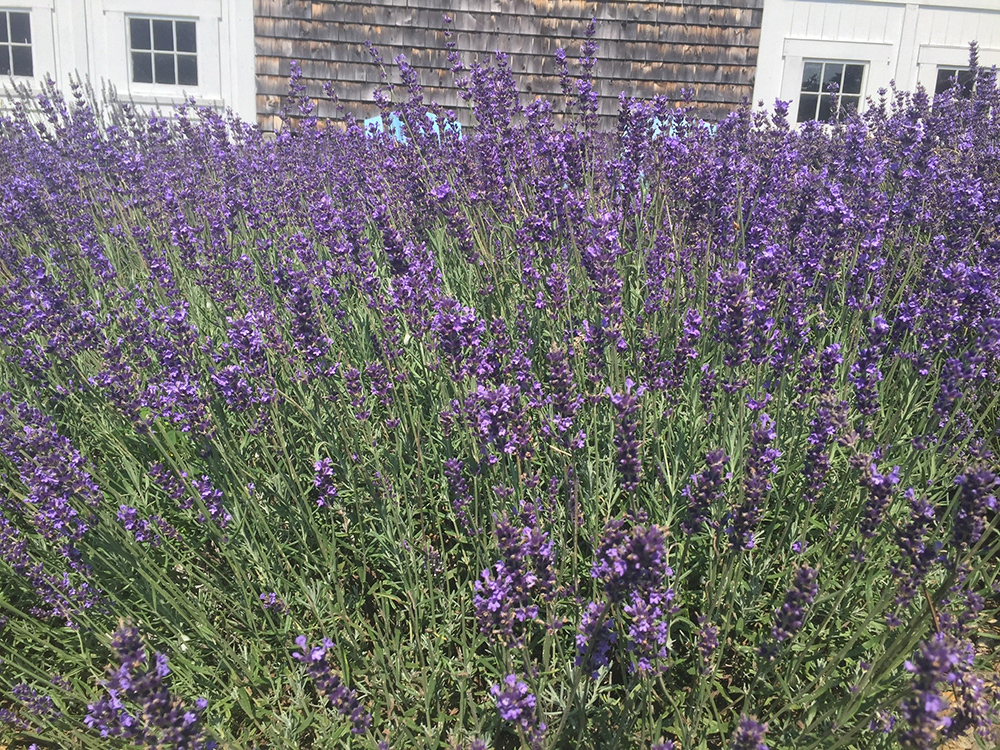Let It Grow
By Tammy Thornton
Years ago, while my husband and I were on a New England vacation, we realized that a lavender farm was located near the town we were visiting. What a glorious detour from our original plans. Walking through the purple fields while bees happily buzzed around was the stuff that dreams are made of. You could almost imagine that you were living in Provence. Fortunately, under the right conditions, you can grow beautiful lavender right here at the Jersey Shore.
Run your hand over lavender flowers and you will be smitten. The unique calming aroma, beautiful purple flowers, and gray-green foliage can transport you to a peaceful state of mind. The airy purple flowers serve as a neutral, combining well with other colors in the garden and as a cut flower in bouquets. Not only does fresh lavender appeal to the senses, but dried lavender flowers can happily find their way into soap, candles, and sachets. Bring lavender into your kitchen, and the possibilities are limitless.
Of course, I’ve always wanted to possess this alluring plant in my own garden, but struggled to keep lavender alive. As you may know, this Mediterranean plant needs loads of sun and well-drained soil. In my garden, sunny spots come at a premium. Though I am fortunate to have sprinklers watering my garden, lavender is extremely susceptible to root rot, and constant watering will cause its certain demise. When our neighbor’s tree fell from a nasty storm, the missing tree turned my part-shade corner into a full-sun zone. This little secret garden spot is also beyond the reach of our sprinklers, making it the ideal place for sun-loving lavender to thrive.

Keep in mind that though lavender must have well-drained soil, this doesn’t mean it shouldn’t be watered. New plants should be watered once or twice a week, until they are established. When the plant matures, you can decrease watering to every two to three weeks, until you see buds forming. At this point return to watering once or twice a week until harvest. Our sandy South Jersey soil provides the perfect conditions for well-drained soil. If you have a slope to your garden, plant the lavender where the water will drain downwards, away from the plant. I have found that I can achieve better results by planting my lavender in pots instead of in the ground. Unglazed ceramic pots will dry out quickly, which is a good thing when it comes to lavender. As a plus, potted plants will give the look of a Mediterranean garden. Lavender can thrive in poor to moderately fertile soil, but be sure to add small stones or pebbles to the bottom of the pot and sand to the soil mix to increase drainage.
Now that I have been relishing in the fact that I have successfully grown lavender in my garden, thoughts have turned into the many delightful uses of lavender indoors. A few sprigs of lavender look beautiful in a vase with the soft pink of New Dawn roses, and I’m hoping a little sachet under my pillow will help my insomnia. But once your lavender dreams take you away, you’ll want to add lavender to everything. You can dry lavender and add it to oils, scones, cakes, and ice cream. Add lavender to sugar for baking in cookies or making a DIY body scrub.
Though the possibilities are endless, I decided to start small for quick results. Lavender lemonade was a fun way to begin my culinary lavender adventure. Of course, before using lavender for consumption, be sure that you are only using lavender that has not been treated with pesticides. For the lemonade, I cut a handful of lavender flowers including the stems and gave them a good rinse under the faucet to make sure no buggy hitchhikers were around. Then I covered the stems and flowers with boiling water in a small pot and steeped for about 15-20 minutes. At this point, strain out the solids and you’ll be left with a purplish “tea”. I added the strained lavender water back to my little pot and dissolved a bit of sugar, creating a lavender simple syrup. Once this cooled off, I poured my base into a glass carafe and squeezed the juice of two lemons into my concoction, which instantly changed the color to almost pink. (Some people add food coloring to give their lavender a more purple color, but I felt this was cheating). Then I filled the carafe with more water and chilled my lemonade in the refrigerator. For an extra fun touch, I made flower ice cubes by adding lavender flowers, mint, and pansies to ice cube trays. These flower ice cubes added a whimsical touch and were an easy way to embellish the lavender lemonade. My on-site food critic staff (husband and kids) agreed that this lavender lemonade was a refreshing, tasty summer drink. I’m definitely going to include this fun lemonade at my next garden party. The flower ice cubes really sealed the theme.
Once you explore the potential uses of lavender, you’ll want to experiment and grow even more. Fortunately, you can get “free” plants by taking cuttings of your existing lavender to increase your stock. If you really want some inspiration, you can visit lavender farms found right here in New Jersey. We would love to hear about your lavender adventures. Please send your comments, questions, and photos to: shorelocalgardener@gmail.com.
Tammy Thornton lives with her husband, children, and crazy pets while enjoying a life of gardening, cooking, and going to the beach.






